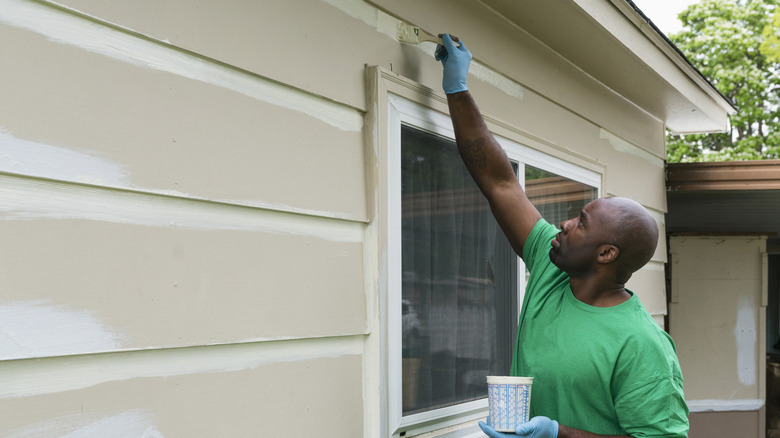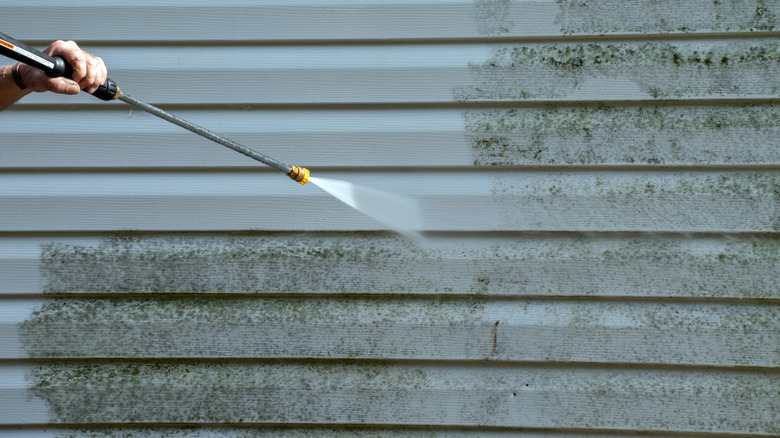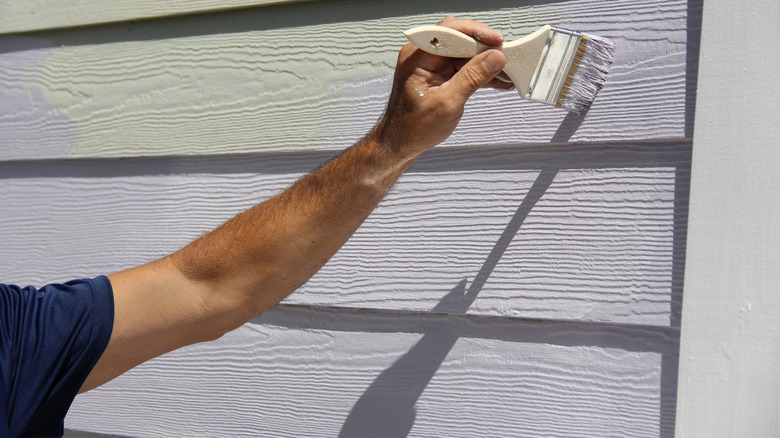Essential Tools Needed To Paint Vinyl Siding Like A Pro
Vinyl siding typically lasts between 20 and 60 years. Although the material itself is durable, you should be repainting the exterior of your home every five to ten years, according to the pros, to maintain its aesthetic appeal and protective qualities. Signs that you should repaint your vinyl siding include fading color, peeling or cracking paint, and visible mildew or mold growth that doesn't come off with cleaning. Additionally, if you notice the siding looking chalky when you rub your hand across it, or if the color has become uneven and blotchy, it's likely time for a new coat of paint. To paint vinyl siding like a pro, you'll need some tools: a pressure washer, paint brushes and rollers, a ladder, exterior paint and primer, drop cloths, painters tape, a caulking gun, and buckets.
While there are plenty of house painting professionals who can help tackle this home project, it's something that most homeowners can DIY in a weekend or two, depending on the size of their home and the weather conditions. By putting this project on your spring to-do list, you can both save money and grow your sense of accomplishment and pride in your home's upkeep. Luckily, the supplies you'll need for this project can all be found at home improvement stores, making it a relatively accessible and straightforward DIY endeavor for most homeowners.
Get ready to paint
The foundation for any good exterior paint job is to choose the right paint. It's best to avoid the common mistakes everyone makes when choosing exterior paint, like not taking the finish into consideration. After choosing your paint, get stocked up on brushes for the job. You'll need a variety of sizes and types, including angled sash brushes for trim work and larger flat brushes for broader surfaces. Don't forget about the rollers — you'll want both standard-sized rollers for large, flat areas and smaller rollers for tighter spots, along with extension poles to make reaching higher areas safer and easier. Having a sturdy and tall enough ladder is also essential for safely reaching all areas of your siding. You'll also want to make sure that you have a few different buckets — one for your paint, another for rinsing brushes and rollers, and perhaps a third for soapy water when cleaning the siding. Before getting started, place drop cloths around any areas, such as patios or decks, that you want to protect from paint.
Once you've gathered the essential tools, you'll want to pressure wash the entire surface of your vinyl siding to remove any dirt, mildew, chalkiness, or loose debris, ensuring a clean and sound surface for the new paint to adhere to properly. Protect areas of the exterior of your home, like around windows, with painter's tape. Before you start applying primer or paint, be sure to patch any holes around windows or doors with your caulking gun.
Make it colorful
You don't have to have experience to paint the exterior of your home like a pro — you just need to know a few fundamental rules. Before applying any new paint, be sure to wear clothing that you're comfortable potentially throwing out — this job can get messy. When climbing a ladder, make sure you have a friend or neighbor as your spotter to ensure your safety and to help with passing tools or materials as needed. Apply the primer first, allowing it to dry completely according to the manufacturer's instructions, as this crucial step promotes better adhesion of the topcoat and helps to achieve a uniform finish. Then, apply thin, even coats of your chosen exterior paint, allowing each coat to dry thoroughly before applying the next to build up color and achieve optimal coverage and durability.
It can take 24 to 72 hours for your vinyl siding paint to fully dry, depending on the type of paint used, the number of coats applied, the temperature, and the humidity. It's generally best to err on the side of caution and allow for a longer drying time, especially if the weather is cool or damp, to ensure the paint cures properly and achieves maximum durability and adhesion. Remember to inspect your siding every so often for peeling or cracks and touch up high-traffic areas as needed. Finally, it's best to wash your siding annually with a mild soap and water solution to remove dirt and mildew, helping to maintain its appearance and prolong the life of the paint job.


